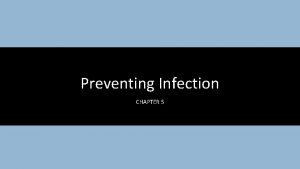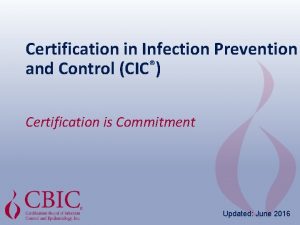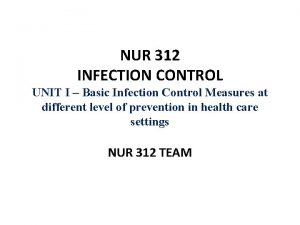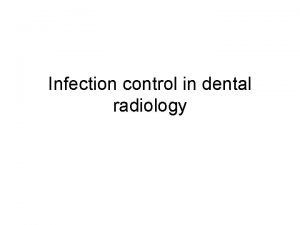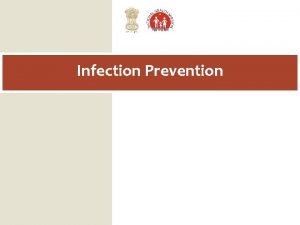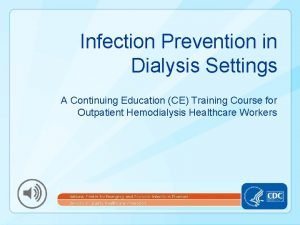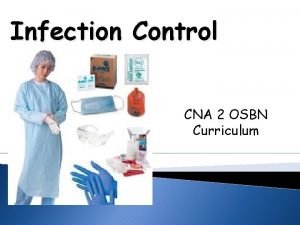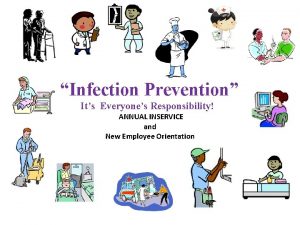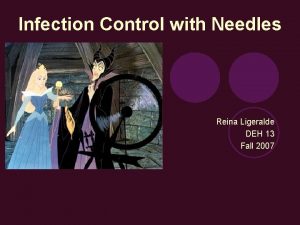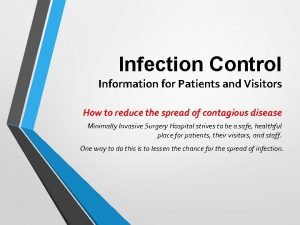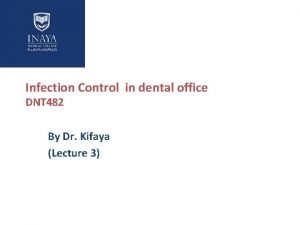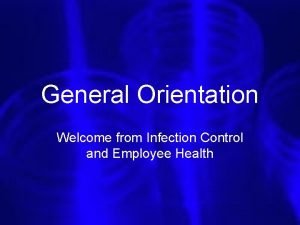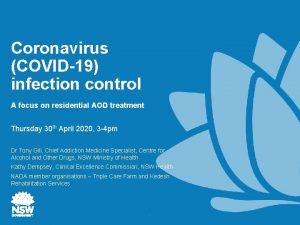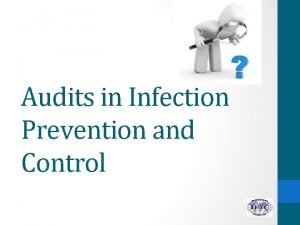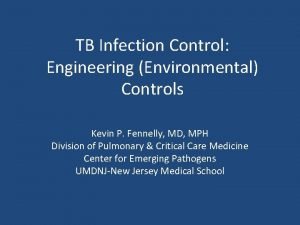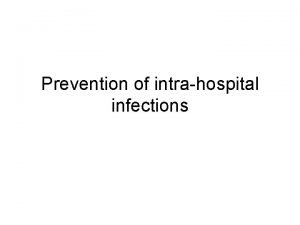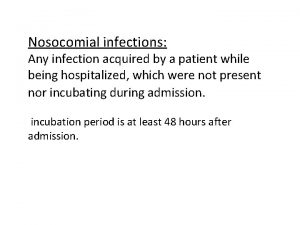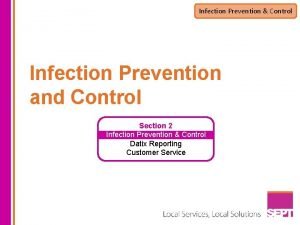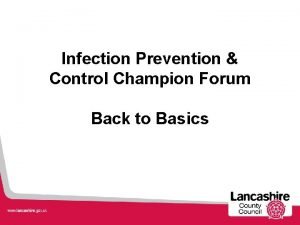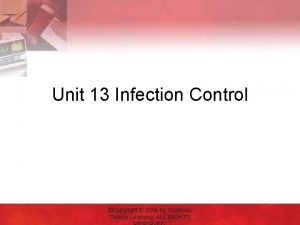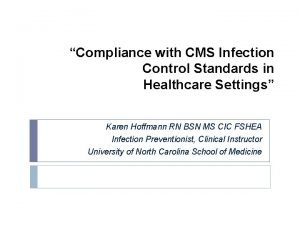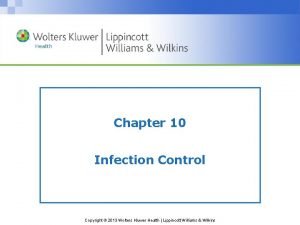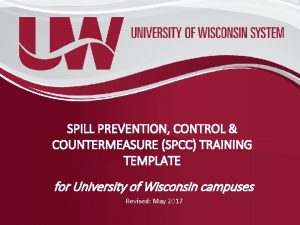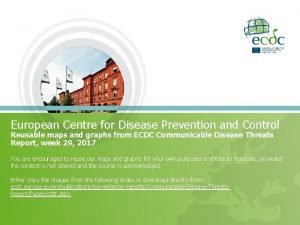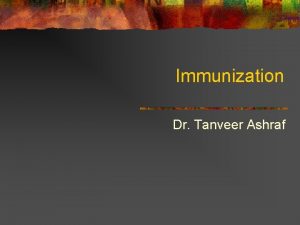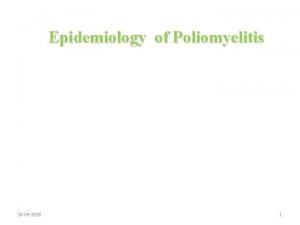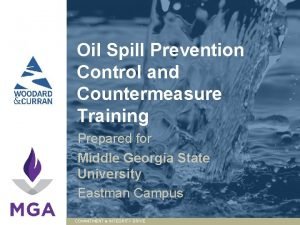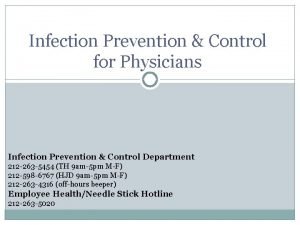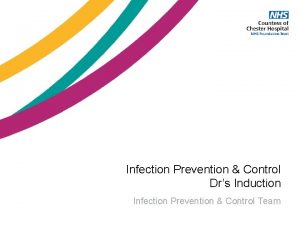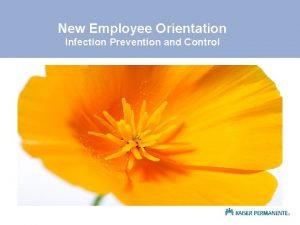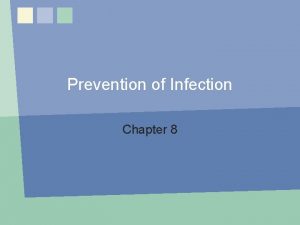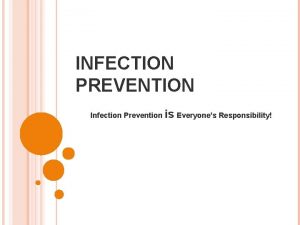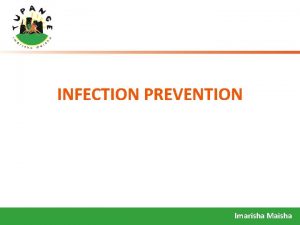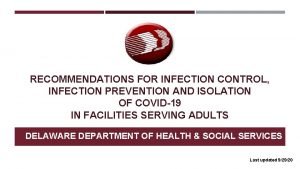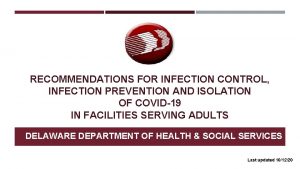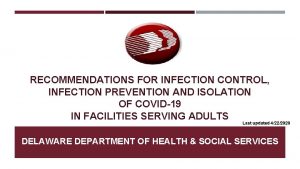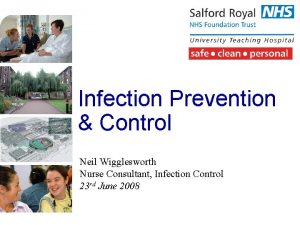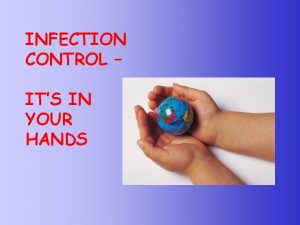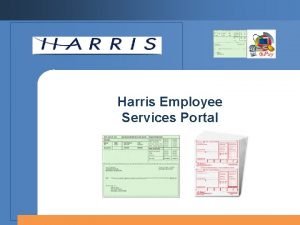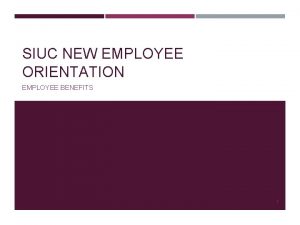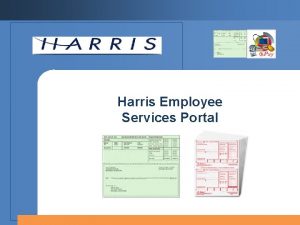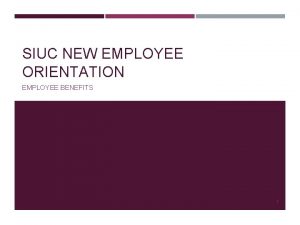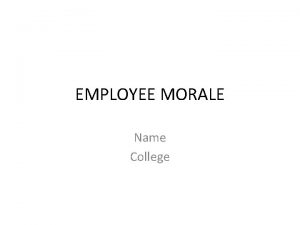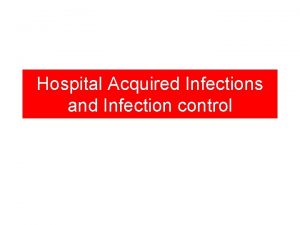INFECTION PREVENTION AND CONTROL Infection Prevention and Employee










































- Slides: 42

INFECTION PREVENTION AND CONTROL Infection Prevention and Employee Health Nurse Stanislaus Surgical Hospital

Preventing the Hospital Acquired Infection

What is an infection? An infection is an invasion and multiplication of microorganisms in body tissues, as in an infectious disease.

Topics of Interest

SIX EVENTS IN PLACE TO CAUSE AN INFECTION 1. Presence of an infectious agent q Virus q Bacteria q Fungus q Protozoa Prevention: Identification of the organism.

2. Reservoirs: Where organisms are found q q YOU Equipment q Surfaces q Water Prevention: q EH screening q Environmental sanitation q Disinfection/Sterilization 3. Portal of Exit: Mode of organisms transferred q Excretions q Secretions q Skin pores Prevention: q Proper personal protective equipment q Hand washing q Proper disposal of trash and waste. SIX EVENTS IN PLACE TO CAUSE AN INFECTION (CONT’D)

q Airborne fomites Portal of Entry q GU tract q Direct contact ingestion q GI tract q Mucous membranes 4. Means of Transmission Prevention: q Hand washing q Sterilization q Isolation q Air flow control q Food handling 5. Respiratory tract q Broken skin q Prevention: q Aseptic technique q Catheter care q Wound care SIX EVENTS IN PLACE TO CAUSE AN INFECTION (CONT’D)

Susceptible Host q Immunosuppression diabetes q Surgery patients q Burn patients q Cardiopulmonary disease 6. Prevention: q Treatment of underlying disease q Recognition of high risk patients SIX EVENTS IN PLACE TO CAUSE AN INFECTION (CONT’D) https: //www. youtube. com/watch? v=Lv. RP 3 c 5 n 3 P 8&feature=em-share_video_user

What are the SIX Links in the Chain of Infection?

ANSWER 1. Infectious Agent 2. Reservoirs 3. Portal of Exit 4. Means of Transmission 5. Portal of Entry 6. Susceptible Host

Reducing the Risk of Infection


Standard / Universal Precautions: Are the most frequently performed basic hygiene “Standard” in all healthcare settings Hand washing at the beginning and completion of a task or when visibly soiled Additional Personal Protective Equipment (PPE), (e. g. gown, mask, face shield, etc. )may be used if anticipating a splash or spray of body substances to bare skin, eyes, or clothing

Enhanced Contact Precautions: • Are initiated when an infection is present in an individual that can be transmitted by contact with bare skin, environmental surfaces, waste, and body substances. • Minimum REQUIRED PPE: Gown and gloves • Private room.

Contact Precautions ISOLATION SIGNS Enhance Contact Precautions

Droplet Precautions: Airborne Precautions: Are initiated when an infection is present • Are initiated when an infection is present in an individual that can be transmitted in in an individual that can be transmitted by droplet form by sneezing or coughing body fine aerosol droplets during sneezing and substances onto people, environmental coughing. surfaces, and waste • Fine aerosol droplets can stay suspended in the air for prolonged periods of time and can easily travel long distances to • Minimum REQUIRED PPE: Eye protection, infect people, environmental surfaces, mask, and face shield if within 3 feet of an and waste. infected person • • • Minimum REQUIRED PPE: N-95 respirator mask, & possible droplet precaution PPE as well Private room • Private room or cohort with like patient

Airborne Precautions ISOLATION SIGNS Droplet Precautions

Bloodborne Pathogens; Exposure Prevention

Bloodborne pathogens are disease causing microorganisms (pathogens) that are carried (borne) in the blood stream Contact with blood, blood components, or body fluids known to carry these could result in you getting a bloodborne disease Requires Know Standard / Universal Precautions what SSH’s Policy and Procedure for Blood

The federal and state regulation (Bloodborne Pathogen Standard), is directed toward three viruses known to cause severe disease, although others are also considered: • Human immunodeficiency Virus (HIV) • Hepatitis B Virus (HBV) • Hepatitis C Virus (HCV)

How are bloodborne pathogens spread? By infected body fluids that enter the body through: §Needlestick injuries §Cuts, scrapes, and other breaks in your skin §Splashes into the mouth, nose or eyes §Oral, vaginal or anal sex §Using contaminated drug needles

What do you do if you have an exposure? 1. Wash laceration or eyes for 10 minutes 2. Milk and wash punctures 3. Flush mucous membranes 4. Contact manager for further assistance

Bloodborne Pathogens; Exposure Prevention

Topic RECAP: What are the first four actions you do if you have an exposure?

RECAP Answer: 1. Wash laceration or eyes for 10 minutes 2. Milk and wash punctures 3. Flush mucous membranes 4. Contact manager for further assistance

TUBERCULOSIS (TB) PREVENTION AND TESTING

q. What is Tuberculosis and how does it spread? Tuberculosis, commonly known as TB, is a contagious and an often severe airborne disease caused by a bacterial infection. TB typically affects the lungs, but it also may affect any other organ of the body. It is usually treated with a regimen of drugs taken for 6 months to 2 years, depending on the type of infection.

People who are at higher risk for TB: § § § § People with HIV disease Anyone who shares close quarters with a person with active TB Foreign-born people from nations with high rates of TB Alcoholics and intravenous drug users Chronically malnourished people Homeless people People with diabetes or silicosis People who live or work in nursing homes, prisons or TB treatment centers

q What environmental factors increase risk of transmission? § Exposure to TB in a small enclosed space § Inadequate local or general ventilation § Recirculation of air containing infectious droplets

Latent Phase caries the germs, but cannot infect others Active Phase q Person q This They: person carries the germs and can infect others § Do not look or feel sick § Cough for > 3 weeks § May have preventative treatment recommended to reduce the chance it will become an active disease § Feel weak § Have a fever § Unexplained weight loss § Loss of appetite § Experience night sweats § Cough up blood § Painful coughing

q California State Safety requirements : § New hire employees are required to have a two step TB Skin Test prior to starting or a Chest X-ray to rule out active infection § Annual TB Employee Health Screens: TB Skin Test Record or TB Symptoms Questionnaire § HCW must be Fit-Tested for N-95 Mask / Respirators § Patients with active TB must be in a single Airborne Infection Isolation Room with Airborne Precautions

Influenza

Influenza (flu) is a contagious respiratory illness caused by influenza viruses. It can cause mild to severe illness. Serious outcomes of flu infection can result in hospitalization or death. Some people, such as older people, young children, and people with certain health conditions are at high risk for serious flu complications. The best way to prevent the flu is by getting vaccinated each year. (Herd Immunity) - Center for Disease Control and Prevention

Requirements for inpatient/outpatient care: Droplet precautions. Respiratory and Cough Etiquette Visitation requirements change during influenza season to minimize exposure to vulnerable patients and staff The California Department of Public Health; Stanislaus County Public Health Officer Dr. John Walker, initiated mandatory masking order for all HCW who have chosen to not be vaccinated. This order will be for the entire influenza season (Nov. 1 - Mar 31).

RECAP: Respiratory and Cough Etiquette Stay home if you’re sick to prevent the spread of the flu HAND HYGEINE!

PREVENTING WORK RELATED INJURIES

Work related injuries are preventable Healthcare workers are at a higher risk for injury due to exposure to ill patients, physical tasks, and environment. Cal-OSHA have many safety requirements for employers to enforce SSH has developed a free to report culture on all malfunctioning equipment and environmental hazards (work order)

Back injuries are very common in the healthcare setting. Things to avoid: • Twisting at the waist while lifting • Over stretching to reach an object • Lifting or carrying objects that are awkward in shape • Lifting or carrying objects that are too heavy • Bending your back to lift an object

Things we can do to minimize injuries: • Assess the job at hand • Redesign if possible (raise or lower shelves) • Test the weight of an object before lifting • Stand close to the load when lifting and carrying • Bend at the knees not the back • Get help • Use a dolly or push cart to transport objects

RECAP: There are five safe lifting techniques an employee can do to minimize back related injuries. What are they?

RECAP Answer: 1. Stand close to the load 2. Bend at your knees; not your back 3. Let your legs do the lifting 4. Get help for heavy or awkward loads 5. Use the right tools

QUESTIONS?
 Primary prevention secondary prevention tertiary prevention
Primary prevention secondary prevention tertiary prevention Chapter 16 infection prevention and control
Chapter 16 infection prevention and control Chapter 19 disease transmission and infection prevention
Chapter 19 disease transmission and infection prevention Chapter 19 disease transmission and infection prevention
Chapter 19 disease transmission and infection prevention Chapter 19 disease transmission and infection prevention
Chapter 19 disease transmission and infection prevention Employee attitudes and employee performance
Employee attitudes and employee performance Define infection prevention chapter 5
Define infection prevention chapter 5 Chapter 16 infection control and standard precautions
Chapter 16 infection control and standard precautions Tuberculocidal disinfectants milady
Tuberculocidal disinfectants milady Cbic recertification
Cbic recertification Dental radiology ppt
Dental radiology ppt Chapter 15:9 maintaining transmission based precautions
Chapter 15:9 maintaining transmission based precautions Chapter 15:2 bioterrorism
Chapter 15:2 bioterrorism Cic exam certification
Cic exam certification Infection control definition
Infection control definition Darkroom infection control guidelines
Darkroom infection control guidelines Learning objectives for infection control
Learning objectives for infection control Infection control conclusion
Infection control conclusion Osbn cna
Osbn cna Infection control is everyone's responsibility
Infection control is everyone's responsibility Infection control
Infection control Tier 1 standard precautions
Tier 1 standard precautions Infection control information
Infection control information Root locus drawer
Root locus drawer Infection control orientation
Infection control orientation Infection control
Infection control Infection control audits
Infection control audits Environmental controls infection control
Environmental controls infection control Examples of service excellence in healthcare
Examples of service excellence in healthcare Infection control committee
Infection control committee Conclusion of infection control
Conclusion of infection control 10 principles of infection control
10 principles of infection control Infection control champion
Infection control champion Unit 13 infection control
Unit 13 infection control Infection control surveyor worksheet
Infection control surveyor worksheet Chapter 10 infection control
Chapter 10 infection control Spill response steps
Spill response steps Colorado division of fire prevention and control jprs
Colorado division of fire prevention and control jprs Chapter 26 infectious disease prevention and control
Chapter 26 infectious disease prevention and control European centre for disease prevention and control
European centre for disease prevention and control Prevention and control of poliomyelitis
Prevention and control of poliomyelitis Prevention and control of poliomyelitis
Prevention and control of poliomyelitis Spill prevention control & countermeasures training
Spill prevention control & countermeasures training






